The More Things Change...
- Rob Shoaff (rshoaff@foundrymakerspace.com)
- Apr 27, 2018
- 11 min read
Original French quote "plus ça change, plus c'est la même chose" (Les Guêpes, January 1849)
- Jean-Baptiste Alphonse Karr (24 November 1808 – 29 September 1890)
- Les Guêpes was his monthly journal, which was digitized by Google and is part of the Internet Archive.
The longer I am on this planet, the more this old adage makes sense and is true. It leads me to believe that there are universal principals deeply imbedded in our existence. One of my favorite film does a great job illustrating the meaning of Karr's quote. It is the 1977 Charles and Ray Eames film The Powers of Ten (https://www.youtube.com/watch?v=0fKBhvDjuy0) At one point in Part 2 (about the 5 minute mark), the narrator says "noticing alternation between great activity and relative inactivity." (transcript reference - http://www.mmryan.net/archive/archdesign/eames/powersoften/CLL/artsandstarsenslyonfrERRORS/transcript_artsandstarsenslyonfrERRORS.pdf). So the more things change through the powers of 10, the more there is the same - activity and non-activity.
Through March, there has been a lot of making at the schools within and outside of the Foundry effort. This is a good positive indicator of Capacity Building. As I talked about in my February blog (http://cfrey9.wixsite.com/foundrymakerspace/single-post/2018/03/08/We-Are-All-Brethren), the term Capacity Building has been on my mind the past few months. It has been at the school level, at the community level and at the government level. I've also been seeing issues at the national level.
Let us take some time to go through the making in 4 Sections of this blog and while we do, let us consider the successes and student growth in light of Capacity Building:
At the High School Campus of John Harris
At the High School Campus of SciTech.
At the 3/16F 3rd in the Burg Midtown Minecraft and 3/19M Maker Monday workshop on the Sketchup App.
Through those events our own Nathaniel Bechtold learned how to 3D model to put the doll baby, Mary, back together. This was a side project that was given to us by Tasha James at the Women of Color Network, which is located in StartupHbg.
Happy Making!
STEAM Making @ John Harris Campus High School
TECHNOLOGY:
STEM Lab (Mr. Gigac)
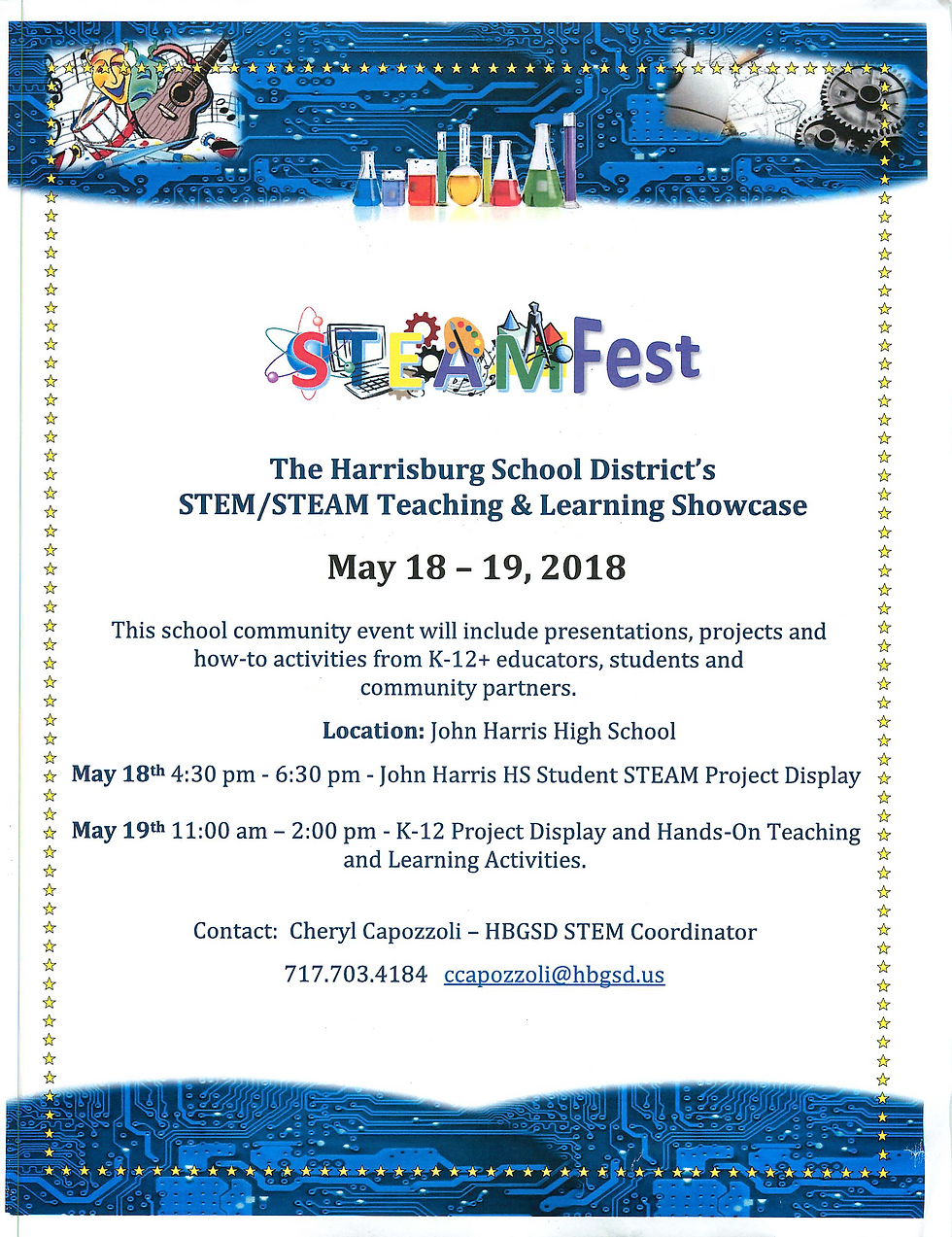
I've been helping Mr. Gigac in planning out the STEAM Showcase, which is being held on Friday, May 18th and Saturday, May 19th. He is working on the types of STEM Lab project to showcase. So far the list is
Student Displays:
Alternative Hydrogen Car
Alternative Energy Solar Powered Car
Bridge Design Simulator
Fishertechnik
LEGO Mindstorms
Photoshop Photo Editing
Premiere Video Editing
Scratch.mit.edu
Snap Circuits
Zometool Geometry Bubbles
Instructor Display:
Carvey CNC
Dremel 3D Printer
DIGITAL ARTS & MEDIA:

STEM Lab (Mr. Cooper)

The students continue to produce the Weekly Series for the John Harris Campus High School Cougar TV News Network.
For the Tuesday, March 6th 500 Men Reading event, the students had the opportunity to interview Good Morning American news personality, Ronald Claiborne http://www.adweek.com/tvnewser/ron-claiborne-celebrates-30-years-at-abc-news/297674. That recorded interview can be seen on the Cougar TV Youtube Channel.
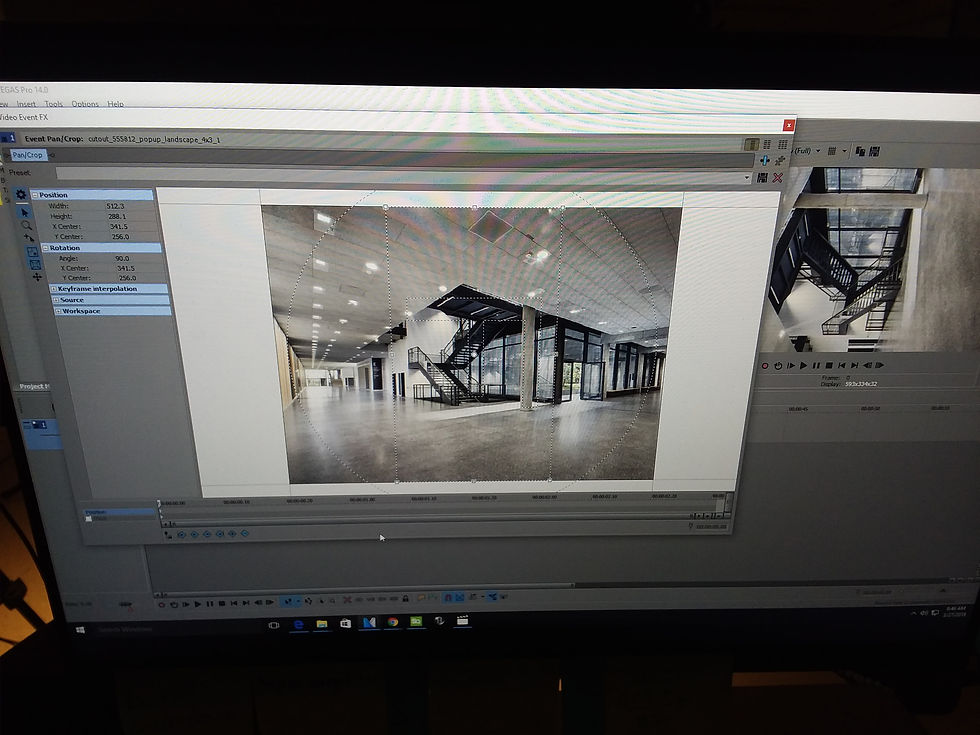
Mr. Cooper was also helping out on the Celebration of the Arts event at John Harris Campus High School on Saturday, March 24th. He teamed up with Marshall Math & Science Academy Middle School's Johntrae Williams to provide a makeshift AV Studio and DJ workstation to demonstrate creativity with technology. Visitors could go in front of the camera with a green screen to compose a virtual set with vMix Life Production Software. Others could have the opportunity to DJ using a Hercules usb DJ deck. There was one AV Studio Crew Member who showed up to help assist with the equipment.
The event also included high school students from the SciTech Campus. More information about those activities can be found in the next section below.
Lastly, on 180327, a student in the AV Studio asked how he and some other students could create a camera roll transition as seen in the FX series Atlanta. For the series there is a teaser trailer which shows a static camera with rotating background with the central character Earnest 'Earn' Marks, played by Donald Glover. It is a pretty amazing and creative visual trick. The student found a great Adobe Premiere tutorial published by Cinecom.net on 180323. Since we have easy access to Magix's Vegas Pro, I decided to show him how it might be possible with just a static photo. The above photo shows how this was setup. It was a great working brainstorm session that got the student to think about the possibilities (still photos and live video) for this affect around the John Harris Campus. I cannot wait to see what they dream up.
STEAM Making @ SciTech Campus High School
SCIENCE:

Trout in the Classroom (Ms. Roberts)
The trout are doing well at SciTech, Marshall Math & Science Academy, and Camp Curtin Academy. Due to several snow days, the planning of the Trout Release Day has been slowed down. We are looking at an end of April release date. As this project comes to a close we'll be going through the Program and Learning assessment to review the connections with 4Cs and Common Core lessons.

TECHNOLOGY:
SciBOTS Robotics Team (Robert Steps)
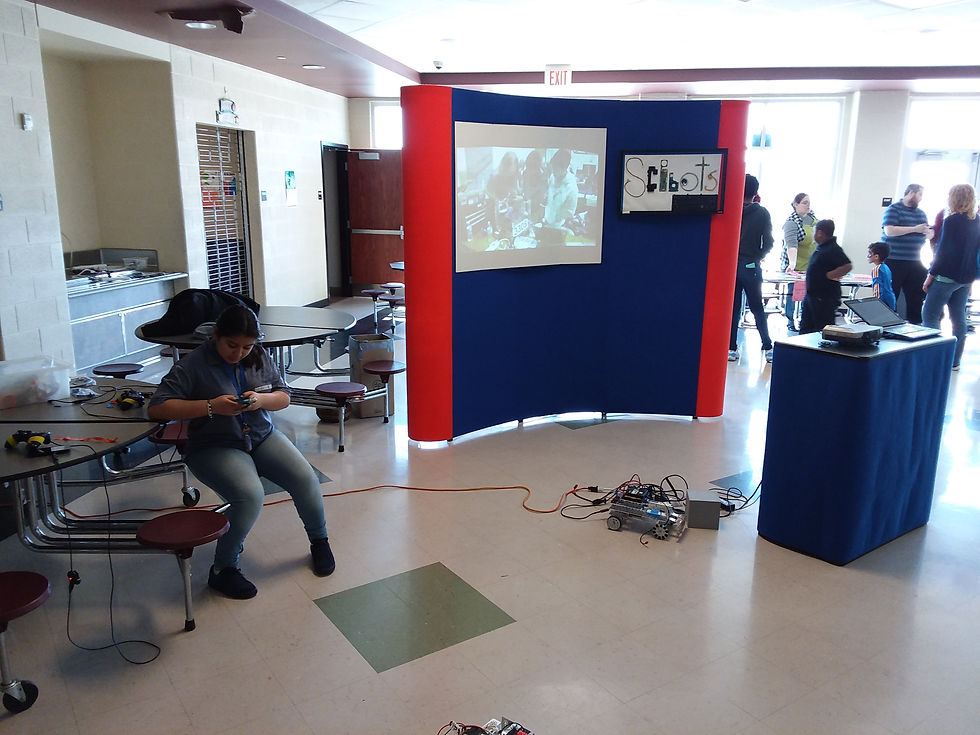

Three SciTech Freshman attended the Celebration of the Arts to help promote the FIRST Tech Challenge SciBots club. This event allowed the students to reach out to Elementary and Middle School students who were interested in robotics. The Foundry helped in the event by providing 3D Printing and Quad Copter demonstrations.
Many people were amazed to see the DeltaPrintr Go printer in action. Mr. Jonathan Wheat, the SciBots Team Community Coach, also brought his 3D Printer while he assisted the Robotics demonstrations. Visitors could control LEGO Mindstorms robots using game controlers. The two FTC Competition Robotics were also on display (3305 Scibots 2 - Senior Team - Rank 28 and 3283 Scibots 1 -Freshman Team - Rank 33).

ARTS:
STEM Lab (Mr. Elo)

The students of Mr. Elo's Digital Graphics class were in the process of working on their PSA projects through March. They were a bit hampered because of the effort to get graphic design projects display ready for the March 24th Celebration of the Arts event.
At the Celebration of the Arts, a 3D Printed sculpture from one of Mr. Elo's students, found its way to the Spirograph Table. It was a good prop to use in discussing how to manipulate 3D printed objects.
STEAM Making @ Foundry Makerspace @ StartupHbg
MAKER MONDAY:
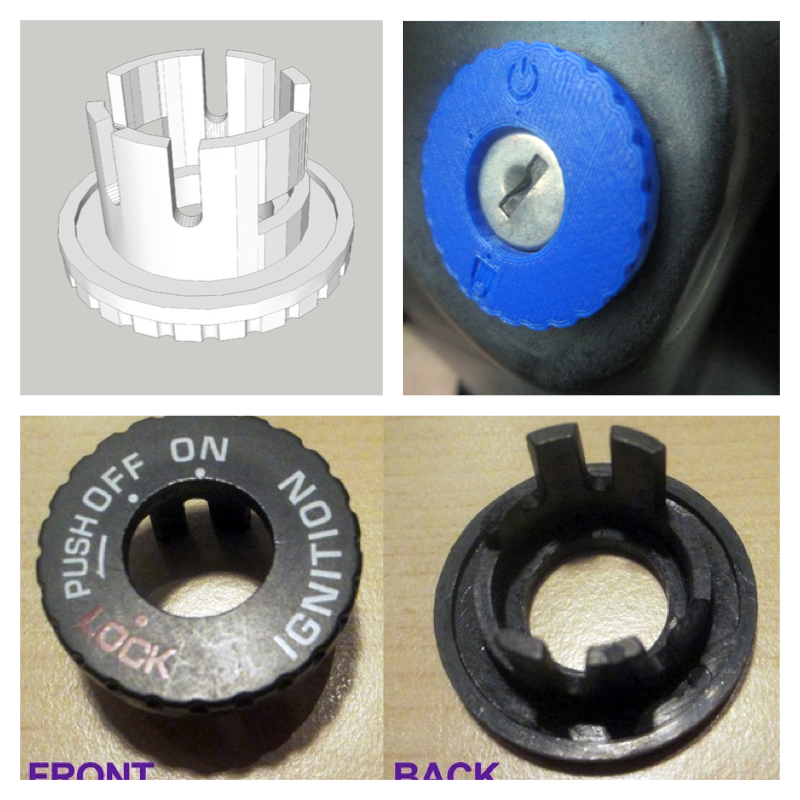
The final installment of 3D Printing Series of Maker Monday happened on Monday, March 19th. I had the opportunity to demonstrate the Sketchup web app - https://app.sketchup.com/.
We had two attendees and I covered how Sketchup can be used to visualize anything from small parts to large scale cities. I first saw Sketchup back in the early 2000's. I was working in Philadelphia with WRTDesign and this software caught my eye. It was designed by the Boulder Colorado software company, @Last. In 2006 it was acquired by Google and they connected it to Google Earth in Google Sketchup v6. Finally on 4/26/2016, Trimble acquires the software from Google to connect it to their GPS/surveying knowledge.
Early on Sketchup was dismissed by many of my colleagues. The deemed it "inaccurate" or just a gimmick distracting from "real CADD / architecture." These comments reminded me of my early days when I was attending HACC and saw Alias' Upfront and Gimeor Inc.'s Architrion at the 1992 National AIA Convention in Boston, MA. Both of these were the early starts of Building Information Modeling (BIM). This was years before Revit would surface. These digital tools were a constant interest to me. However, the computer power just was not meeting the needs of real time visualization.

Then at NYIT, I attended a presentation in NYC for Nemetschek's Allplan FT (Future Technology). This software was mind-blowing because it was parametric because things were represented as grouped 3D objects (walls, doors, windows) and not just 2D lines in blocks. When you put a door into a wall, the software would remove the wall so the door was an opening. This was groundbreaking and harkened back to Architrion.
Then in 1997, while I was at MIT, I saw the release of Charles River Software's (Revit Technology Corporation) Revit ("revise-it"). At this point in time, computer power had hit Pentium III and through more capable memory & video cards, computers could begin to handle complex realtime visualization. On a side note, I researching this blog post, I discovered that this company CRS/RTC was responsible for Parametric Technology Corporation's (now PTC) Pro/ENGINEER (which is now PTC Creo).

This is important on a personal note because I followed Revit from Boston to when I moved my family to Philadelphia. In 2002 Autodesk purchased Revit Technology Corporation. It wasn't until 2005-2006 that I saw Revit in an office demo at WRTDesign. I had been promoting it around the CAD Support Team and they were planning to use it on a single project. This was the issue in many firms, taking the risk of using the software for the length of a project - Pre-Design, Design Development, and Construction Documents. Even at that time I saw Revit applied best on fairly rectilinear and repetitive designs. When I moved my family to Harrisburg, I started teaching Part Time at HACC in 2006. I followed the shift of to BIM as I kept up with the Architecture, Engineering, Construction (AEC) Industry.
SKETCHUP LESSONS:

I talk a lot about visualization in 3D design/modeling. I cannot stress how important this need is for the future. 3D is here as part of everyday lives in Fabrication and Virtual Reality.
I love to introduce people to Sketchup anyway I can. Our Ben Franklin Maker Fellow Nathaniel wanted to learn 3D. At StartupHbg there was a need from Tasha James who works for the Women of Color Network. Last fall she brought me her daughter's doll (Mary) that literally lost her head. Due to an engineering flaw, the plastic part that joined the head to the body broke. Tasha wondered if I could do anything to help.
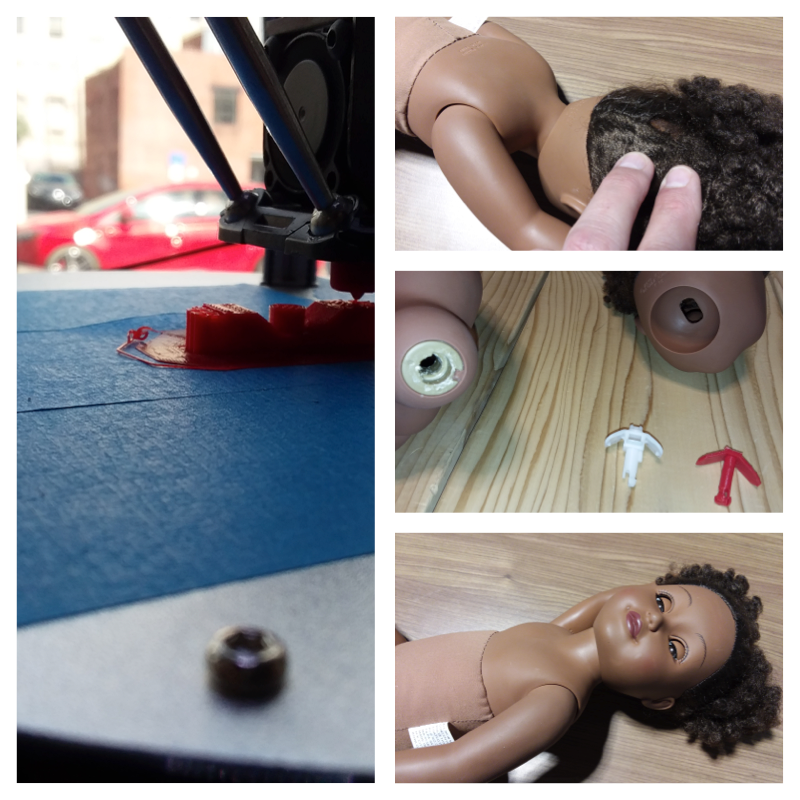
Nathaniel saw the doll on the 3rd in the Burg event on 3/16 and wanted to try and reverse engineer the part. We started by having to cut into the back of the doll's head at the hair seam. This was the only way we could get the part out of the head. Because it was an injection molded part, we were unable to compress the "wings" to squeeze it back through the opening at the base of the next.
After we got the part out, we started taking measurements and modeling the simple geometries in Sketchup. I helped Nathaniel with the basics and he did an excellent job putting it together.
When the model was complete, we then printed it on the DeltaPrintr Go. Our first print wasn't right and it would not go back into the hole at the base of the neck. I made some adjustments to the diameter so it was smaller. The second print contained too much printed material and didn't not flex. Finally with another modeling adjustment the part fit. It was a tough project because there was only one shot of getting it to work because the part would lock in. If it didn't work, I would have to pull the head off again. I hesitated in putting things back together because I thought of ANNEALING the PLA. I had watched a video from Hackaday.com about this process when I was making the Foundry sign for our space in StartupHbg. I went through with putting things together and the part seemed to keep the head on the body. It was a success, but I let Tasha know that it might happen again because I didn't strengthen the part. Thankfully we have a 3D model to reprint and we'll make sure to bake the PLA for the next attempt.
This is what making is all about, pushing through failure. I reiterated this during the Friends of Midtown Board Game Day on 180325. One of the hosts mentioned the need for learning to loose well when playing games. He connected it to the 3D printing I was doing and having the mindset to test things out and if the part failed, I could modify the model and try it again. That isn't an easy mindset to be in, but it does take an effort, "the more things change, the more they remain the same."
To me, that phrase means getting to a point where our constant because change. To push through failure and adversity to the point that it is a "character constant."
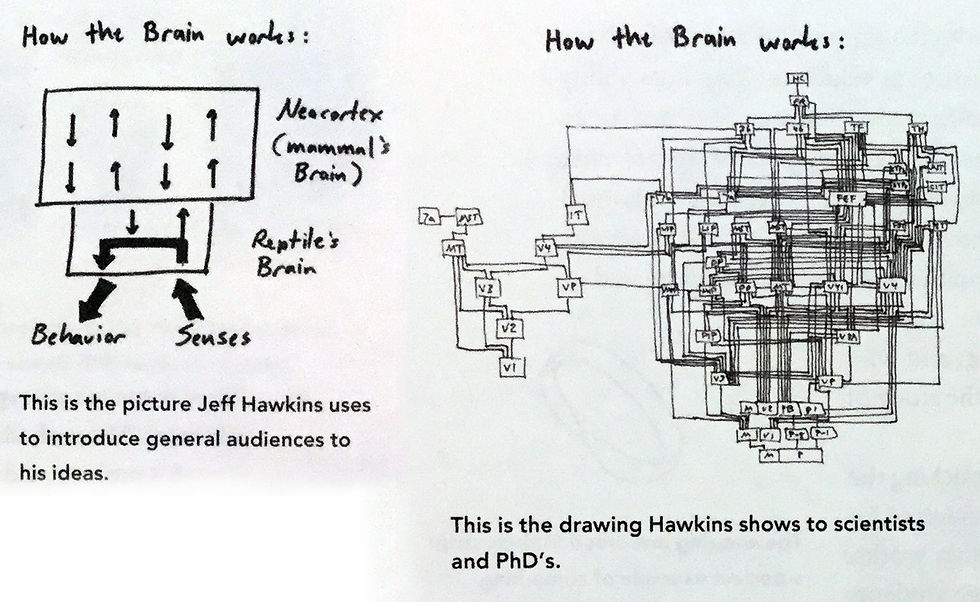
So before getting back to Capacity Building, let's take a side trip down this idea of VISUALIZATION through the experiences of Maker Monday. I have to share this interesting story from Dan Roam's book The Back of the Napkin: Solving Problems and Selling Ideas with Pictures. On pages 113 & 114 Roam describes a story about the need for either simplistic or complex visualization. He describes the work of Jeff Hawkins, who's background is engineering and he started a company Numenta. He has a great 2003 TED Talk How Brain Science Will Change Computing.
Roam describes two images that Hawkins uses when talking to various audiences. I have included a scan from the book because I couldn't fine one of the images online. The one on the right is a complex illustration of how the brain works. A color version can be found at the 131008 anonymous blog Headbirths: On Hawkins, Hierachry, Homunculi and the Hippocampus. Hawkins uses this image when speaking with colleagues in medicine and neuroscience. The second image on the left is simplistic. The detail is reduced to a few shapes, arrows and text. Hawkins uses this for lay audiences. He understands that there are two types of visual understanding.
Both images are important and convey the same information. The important point is that they are received in two different ways. With the one of the right he uses to gain "intellectual credibility" because his colleagues will understand the complexity, or at least consider it a demonstration of what the knowledge that Hawkins has acquired. The one on the left allows for people to connect to the depth of knowledge that Hawkins has acquired. Roam writes that it would be a mistake if the images were switched when presenting to the two audiences.
If the simplistic image on the left were used during a presentation to experts and other neuroscientists, they would question Hawkins' "intellectual authority and credibility" and would tune out of the discussion.
If the complex image on the right were used during a presentation to a general public audience, they would probably fail to grasp anything that Hawkins is meaning to convey and would tune out of the discussion.
Upon reading this, I was astounded that this anecdote described some of the frustration I have had in the world of architecture and urban design. It is difficult to convey 3D space in 2D dimensional working/construction drawings. Ask any architect or designer and they will have plenty of stories about miscommunication. Equally laypeople are frustrated at not understanding 2D dimensional working/construction drawings and wondering if an architect/design builder/contractor is pulling one over on them.
Visualization is valuable.
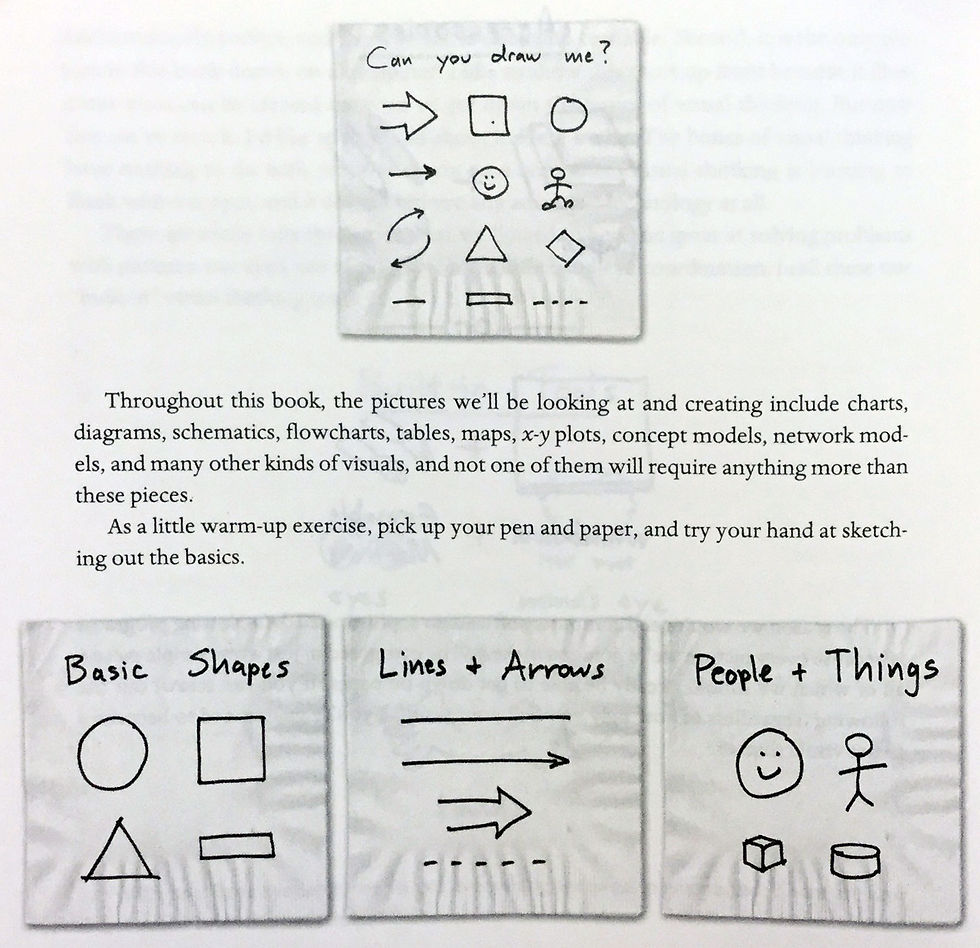
I always revert to telling the story of my first year of architecture school design studio. The professors all work to rebuild visualization. Our education system tends to focus on visualization (space / objects / drawing / art) up through the end of elementary school. In our middle and high school education, other areas are deemed more "valuable." STEM, Reading, Writing, etc. become the focus.
This is why I find Dan Roam's Back of the Napkin book an important topic, which could be something to build into a workshop. Equally important is his other book book Show and Tell: How Everybody Can Make Extraordinary Presentations. I picked up that book recently and I hope to have some insight to share during my April blog post.
Before I return back from this side trip, I have to give a shout out to Mr. George Elo at SciTech. He gave me a copy of the Dan Roam book that he picked up at the local Goodwill. I was deeply appreciative to this gesture. I bring it up on this blog, which has a general theme of Capacity Building. I see it as a small act of Capacity Building within the school. The knowledge of the Foundry has been strengthened at SciTech and Mr. Elo saw the value of collaboration and supporting the effort. The sharing of ideas is growing, which is a surefire element of trust and the desire to walk together down a path the yields greater results.
So back to this idea of "how is Capacity Building measured?" It just isn't in the making as that could be a distraction to show "being busy." I think it is best represented through mimicry. To build on existing best practices. When others begin to mimic methodologies of being better. It is a snowball effect. It starts as a small effort and then it begins to wear off on others. It could be within a classroom, or within a group of teachers at school, or the entire school. A key component to this being successful is promoting an atmosphere that allows this to thrive. Just as a parent would encourage their child to push past failure and thrive, the same happens to adults. If there is a support structure. Things will grown. If the atmosphere is toxic, one would not expect things to be sustained for a long period of time. Something has to give.
I think it is in reaching that "character constant." That our action because a habit. This needs to be developed, nurtured, and after 44 years on this planet is not second nature.









A great blog, it has a lot of useful information to me
Explainer Video, 3d 2d Animation Video makers, Corporate Video Production Company in Bangalore